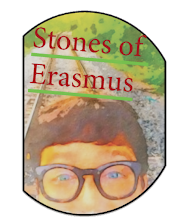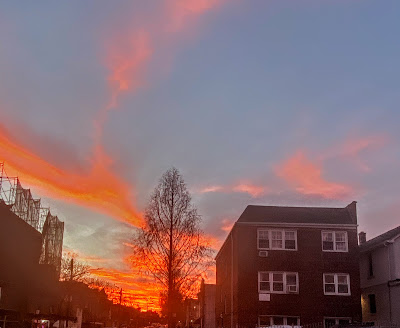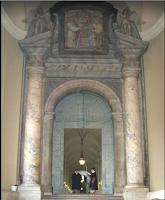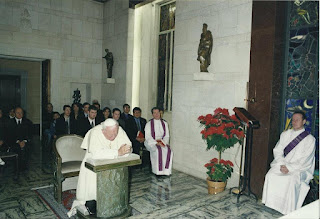Hi, I’m Greig — welcome! Here you’ll find sharp writing, creative ideas, and standout resources for teaching, thinking, making, and dreaming in the middle and high school ELA and Humanities classroom (Grades 6–12).
5.1.21
Storytime: Anthony’s First Day at Kindergarten
 I am an educator and a writer. I was born in Louisiana and I now live in the Big Apple. My heart beats to the rhythm of "Ain't No Place to Pee on Mardi Gras Day". My style is of the hot sauce variety. I love philosophy sprinkles and a hot cup of café au lait.
I am an educator and a writer. I was born in Louisiana and I now live in the Big Apple. My heart beats to the rhythm of "Ain't No Place to Pee on Mardi Gras Day". My style is of the hot sauce variety. I love philosophy sprinkles and a hot cup of café au lait.
2.1.21
Hollywood Movies from the Nineties: Don't Tell Mom The Babysitter's Dead (1991)
 |
| Christina Applegate in Don't Tell Mom The Babysitter's Dead © 1991 |
Don't Tell Mom The Babysitter's Dead is a movie about transformations.
Her boss tells her to say, "I'm right on top of that, Rose!" whenever she is doing a task for her. She says cheerily, "Don't feel overwhelmed, just do one thing at a time." The movie captures the era of big shoulders and women in the workplace trying to make their mark. Sue Ellen works her way up the corporate ladder, getting that Q.E.D. Report done by some cool delegation — to the ire of one of her co-workers, played by Jayne Brook, who is catching on to Sue Ellen's ruse. But Rose thinks Sue Ellen is just the best. "You're a paragon!" she beams! But Sue Ellen, the newest hire at General Apparel West, is really just a kid. The big conceit of the movie is that Christina Applegate is not really a fashion mogul.
"I'm Right On Top Of That, Rose!"
If you don't know the plot, it's ostensibly a story about every teenager's dream — to have the house entirely to yourself, no rules, no boundaries. See. Mom (played by Concetta Tomei) has gone to Australia and left the kids, played by Christina Applegate, Keith Coogan, Robert Hy Gorman, Danielle Harris, and Christopher Pettiet, with an evil-eyed, petty authoritarian (played by Eda Reiss Merin) named Mrs. Sturak. Even the name connotes fear. But the thing is — the movie is not about navigating the conflicts brought on by a mean babysitter. Mrs. Sturak dies twenty minutes into the movie. And Christina Applegate's character suddenly finds herself having to take on the head of the household. In a wild stretch of the imagination, she manages to land a job for a fashion company by stitching together a fake résumé —which hilariously causes her to take on the daily grind, getting up before dawn, to get dressed, prepare breakfast, and beat the downtown Los Angeles traffic to get to work on time. The oldest brother is a deadbeat (Coogan's character) — and the three other kids are treacly sweet, just the way most pre-teen kids are in Hollywood movies from the late 1980s and 1990s. But Don't Tell Mom The Babysitter's Dead is no John Hughes flick. Directed by Stephen Herek, the same guy who brought us Critters and Bill & Ted's Excellent Adventure, the movie takes on a plucky pull-yourself-up-from-the-bootstrap narrative.
Surprisingly Inspiring Movie That Could Otherwise Be Dreck!
The joy of the movie is watching the kids take on adult responsibilities. And the reality is that in the 1990s, many kids were latchkey kids — without parental supervision after school. Like the kids in the movie, learning to take care of yourself, prepping for a meal, setting the alarm on your clock, getting the laundry done, and all of that mundane task that can make life a drudgery were self-taught — this was before "Helicopter Parents." But like I said — the movie is about transformations. The sulky teen girl finds purpose (who isn't rooting for Sue Ellen!). The deadbeat older brother finds purpose in catering! The young kids figure out how to clean the house, take on responsibility, and just be cute in a Hollywood movie. It's been about thirty years since this movie came out — and a lot has changed about everything. The film has aged well, though. The movie is pumped with an optimistic premise — that left to their own devices, kids will take on identities and responsibility and win us over with their aplomb and finesse. Don't underestimate 'em.
What other movies have you seen that show dramatic transformations in teen characters? Let us know in the comments.
 I am an educator and a writer. I was born in Louisiana and I now live in the Big Apple. My heart beats to the rhythm of "Ain't No Place to Pee on Mardi Gras Day". My style is of the hot sauce variety. I love philosophy sprinkles and a hot cup of café au lait.
I am an educator and a writer. I was born in Louisiana and I now live in the Big Apple. My heart beats to the rhythm of "Ain't No Place to Pee on Mardi Gras Day". My style is of the hot sauce variety. I love philosophy sprinkles and a hot cup of café au lait.
25.12.20
Christmas Day Photography Journal: Romantic Musings On Found Objects (And Some Tibetan-style Momo)
Inspired by the Romantics, I find inspiration in the everyday material world.
A bike covered in pigeon droppings. OK. That’s ewwwww. But. Look.
A bowl of grits, green onions, and cheesy eggs.
Me looking at art books.
A snapshot from my favorite mobile game @taptapfish.
 I am an educator and a writer. I was born in Louisiana and I now live in the Big Apple. My heart beats to the rhythm of "Ain't No Place to Pee on Mardi Gras Day". My style is of the hot sauce variety. I love philosophy sprinkles and a hot cup of café au lait.
I am an educator and a writer. I was born in Louisiana and I now live in the Big Apple. My heart beats to the rhythm of "Ain't No Place to Pee on Mardi Gras Day". My style is of the hot sauce variety. I love philosophy sprinkles and a hot cup of café au lait.
17.12.20
Quote: Isaac Watts Admonishes How Idle Hands Are the Devil's Work (And a Reflection on How I Got Into the Habit of Collecting Quotes)
"In works of labour, or of skill, I would be busy, too;
For Satan finds some mischief still
For idle hands to do."
Photo by nacer eddine on Unsplash
 I am an educator and a writer. I was born in Louisiana and I now live in the Big Apple. My heart beats to the rhythm of "Ain't No Place to Pee on Mardi Gras Day". My style is of the hot sauce variety. I love philosophy sprinkles and a hot cup of café au lait.
I am an educator and a writer. I was born in Louisiana and I now live in the Big Apple. My heart beats to the rhythm of "Ain't No Place to Pee on Mardi Gras Day". My style is of the hot sauce variety. I love philosophy sprinkles and a hot cup of café au lait.
11.12.20
Photograph: A Scene of a Winter Gloaming in Queens
 |
| The Gloaming As Seen from 37th Avenue in Queens Looking Southwest |
Words to Describe the Period of Sunset
In the English language there are a few words that can be used to describe that moment between day and night. The most common word is dusk — which I feel like is a broad term to describe that temporal zone in which the sun has dipped below the horizon but a sliver of light remains.
It is part of the larger sunset process, that process seen from an observer on Earth as the day and night cycle. The sun seems to dip below the horizon line, never to be seen again. Our ancestors hoped for another new day — and especially in Wintertime, as the sunlight grows less during the day, we pine for more light — hence the origin of almost every Winter holiday celebration from Diwali, to Hannukah and Kwanzaa, and to Christmas. We look and pray for the restoration of light.
Twilight or Gloaming?
Twilight — which is closer to what the term gloaming means. It is that precious moment where the last dots of lights appear in a reddish, bronze haze of light — and then slowly descend into night.
I imagine gloaming is the more poetic term. Twilight is reserved the scientific view of the event. Read this nice article from the British newspaper The Guardian for a thorough review of the different terms.
I like this time of day — while it is just as likely to capture a similar picture in the morning, when in reverse, we see a similar process in the dawn.
When have you seen a gorgeous dusk? What do you call it?
 I am an educator and a writer. I was born in Louisiana and I now live in the Big Apple. My heart beats to the rhythm of "Ain't No Place to Pee on Mardi Gras Day". My style is of the hot sauce variety. I love philosophy sprinkles and a hot cup of café au lait.
I am an educator and a writer. I was born in Louisiana and I now live in the Big Apple. My heart beats to the rhythm of "Ain't No Place to Pee on Mardi Gras Day". My style is of the hot sauce variety. I love philosophy sprinkles and a hot cup of café au lait.
10.12.20
On the Pleasure of Silence: Remarks from a Modern Human (and Apologies to Alluding to Chevy Chase in Christmas Vacation)
 |
| On a quiet night in early winter, even in New York, there is an inspiration to read, and think, and look out my window. |
No Books at the Dinner Table
I don't fault my father. He was not a reader. But he enjoyed good conversation and didn't like being alone — even at the dinner table. As an adult, I have not turned into my father. But not because I am a reader and he is not — but I let children read whenever they want. Children should never be allowed NOT to read.
The Freedom of Reading
But back to my thesis. The freedom to form ideas is buttressed by silence. Is this the contemplative life? Silence is active in a book full of ideas. The ideas in a book are like taking one bite out of a delicious meal and savoring each morsel. Ideas pumped into the brain from external sources like TikTok, YouTube, random channel surfing on the television — do not have the freedom of “one bite at a time.” It's passive consumption. However, podcasts and audiobooks — I don't argue these are as passive because I find audio more immersive than visual. Don't get me wrong, though. I love the visual. And I love TikTok. I am more or less arguing for reading (and not suggesting one throw the baby out with the bathwater).
Why read? I read for epiphanies. Not for epiphanies I have had but for epiphanies, I have not had.
I am silent, so I can learn of an epiphany in a poem.
When I Read a Good Story
When a story is told, your eyes grow bigger, and you rest awhile, knowing something good is about to come, and you know the pleasant color of a story put together as I go along is sufficient.
I am a storyteller. I tell stories. And I was confirmed in that role today. He called me a poet. His name was Evan — about nine or so. He called me a poet. I pay attention when kids say something important. Which is most of the time.
I told a story about finding a Christmas tree in the forest. We cut it down, a nice one — it was a sufficient size — and we drug it back home to decorate it. Sort of like that scene in Christmas Vacation — the one with Chevy Chase as the avuncular but hapless father -- where he takes his family into the woods to cut down the tree. Something like that. Now that's family.
 I am an educator and a writer. I was born in Louisiana and I now live in the Big Apple. My heart beats to the rhythm of "Ain't No Place to Pee on Mardi Gras Day". My style is of the hot sauce variety. I love philosophy sprinkles and a hot cup of café au lait.
I am an educator and a writer. I was born in Louisiana and I now live in the Big Apple. My heart beats to the rhythm of "Ain't No Place to Pee on Mardi Gras Day". My style is of the hot sauce variety. I love philosophy sprinkles and a hot cup of café au lait.
4.12.20
Video Repost: 2020 Global Teacher Award for the World's Best Teacher is . . . .
 I am an educator and a writer. I was born in Louisiana and I now live in the Big Apple. My heart beats to the rhythm of "Ain't No Place to Pee on Mardi Gras Day". My style is of the hot sauce variety. I love philosophy sprinkles and a hot cup of café au lait.
I am an educator and a writer. I was born in Louisiana and I now live in the Big Apple. My heart beats to the rhythm of "Ain't No Place to Pee on Mardi Gras Day". My style is of the hot sauce variety. I love philosophy sprinkles and a hot cup of café au lait.
26.11.20
Quote: John Heywood On Happy Endings (And Today is Thanksgiving in the United States of America!)
 I am an educator and a writer. I was born in Louisiana and I now live in the Big Apple. My heart beats to the rhythm of "Ain't No Place to Pee on Mardi Gras Day". My style is of the hot sauce variety. I love philosophy sprinkles and a hot cup of café au lait.
I am an educator and a writer. I was born in Louisiana and I now live in the Big Apple. My heart beats to the rhythm of "Ain't No Place to Pee on Mardi Gras Day". My style is of the hot sauce variety. I love philosophy sprinkles and a hot cup of café au lait.
17.11.20
Video Repost: Teen Entrepreneurs Start Their Own Trash Bin Cleaning Service Called The Wash Broz
 I am an educator and a writer. I was born in Louisiana and I now live in the Big Apple. My heart beats to the rhythm of "Ain't No Place to Pee on Mardi Gras Day". My style is of the hot sauce variety. I love philosophy sprinkles and a hot cup of café au lait.
I am an educator and a writer. I was born in Louisiana and I now live in the Big Apple. My heart beats to the rhythm of "Ain't No Place to Pee on Mardi Gras Day". My style is of the hot sauce variety. I love philosophy sprinkles and a hot cup of café au lait.
31.10.20
All Hallows' Eve in Greenwood Cemetery and Sunset Park, Brooklyn (Special 2020 Halloween Post)
In this post, I will regale you with pictures and musings from an All Hallows' Eve visit to Greenwood Cemetery and Sunset Park, Brooklyn. It was a beautiful Autumn Day and we are all cognizant of the need to physical-distance ourselves — so what better way to do that than to be outdoors in a massive cemetery?
Exploring Greenwood Cemetery on All Hallows’ Eve, I scored a handful of great photographs. Located in South Brooklyn, the cemetery is one of the oldest graveyards in the city and is a site of a Revolutionary War battle. @historicgreenwood is also a National Historic Landmark. My friends John and Jennifer joined me; we also went to Sunset Park, my old neighborhood. Scarfed down a torta stuffed with spicy pork at @tacoselbronco, scored a free beer from a passerby, and watched the D train come out of the tunnel on Fourth Avenue — it was a serendipitous day.


 I am an educator and a writer. I was born in Louisiana and I now live in the Big Apple. My heart beats to the rhythm of "Ain't No Place to Pee on Mardi Gras Day". My style is of the hot sauce variety. I love philosophy sprinkles and a hot cup of café au lait.
I am an educator and a writer. I was born in Louisiana and I now live in the Big Apple. My heart beats to the rhythm of "Ain't No Place to Pee on Mardi Gras Day". My style is of the hot sauce variety. I love philosophy sprinkles and a hot cup of café au lait.
25.10.20
On How To Meet a Pontiff (Or, That Day I Attended a Private Audience with John Paul II)

|
|
When I was a Roman Catholic Seminarian, and the very young age of nineteen, I was in a private audience with the then Pontiff of the Roman Catholic Church, John Paul II |
To say that I met and chatted with the leader of the Roman Catholic Church would be a stretch. But I did kiss his ring. And I got to see him in his private chapel and in his private library in the Vatican.
I attended a private audience with about twenty-five other people — mostly priests and seminarians. It was the year 2000—around Christmas time—and I was in Rome with other American seminarians from the American College in Leuven, Belgium (where I was a college seminarian at the Catholic University of Leuven). At the time I was studying to be a priest, and our group was invited to have a private audience. The story went that when John Paul II was a seminarian in Krakow, Poland, his seminary was suppressed by the Nazis and apparently, the American College, in Leuven, had sent over, secretly, supplies, books, and the sort, to Poland, as a sign of support and solidarity.
We were in Rome for two weeks, staying as guests at the Pontifical North American College (located on the Janiculum hill) — but we didn't know what day our audience would happen. There are security protocols one follows when scheduled to meet the Pope. The Vatican gave a call to our group leader, a Benedictine priest named Aurelius Boberek, the night before and he then contacted us to be on the ready. We're meeting the pope!

|
| The Bronze Doors |
The night I heard the message I had to scrap my plans for the following day. I was planning to visit the catacombs of Saint Callistus. Oh well, I thought, a papal visit trumps all of that. So we had to wake up early — to arrive at the Bronze doors of the Vatican Apostolic Palace at the crack of dawn. You enter the doors from the right colonnade in Saint Peter's Square. Once we were green-lit to proceed, we were inside the Apostolic Palace — which extends as a grand loggia, designed by the Renaissance artist Raphael. It serves as an official portal and links up with the jumble of buildings that comprise the palace.
John Paul II had a private chapel in the papal apartments, located in the upper floors of what is officially called the Palace of Sixtus V, where he celebrated an early mass. It was so quiet when we arrived one could hear a pin drop. The Pope enters the sanctuary fully vested and he celebrated the Mass in the old Latin rite style — facing the altar (and not facing the people). I think I read one of the readings for the Mass (Or, maybe I read the intercessions. I cannot remember, exactly). So did my classmate Brent Necaise, who was a student with me — I was from Louisiana and he was from Mississippi). Afterward, the Pope's private secretary, a fellow by the name of Stanislaus Dziwisz, escorted us to the private study (or was it the library?) of the Pope.
It was Christmas time, so in the Pope's library there was a stately Christmas tree with ornaments painted with images of John Paul II. I remember thinking that was funny for some reason. I guess if you are Pope you get used to seeing your image affixed to everything from postage stamps, money, and ornaments. I remember all of the furniture was elegant but not overstated. It was a brightly lit room. And there was a wooden barrister bookcase with nicely appointed leather-bound books.
The Pope entered shortly after we had congregated and took a seat in a white plush chair. Everyone in our group lined up to meet him one by one, by kissing his ring, and stating our home state in the United States. When it was my turn he said softly, "Oh. The Mardi Gras," because it was announced I was a seminarian from Louisiana, and when another seminarian said he was from Kentucky he said, "Oh. Race horses." And it went like that — and each of us received a rosary and a holy card.
 |
 I am an educator and a writer. I was born in Louisiana and I now live in the Big Apple. My heart beats to the rhythm of "Ain't No Place to Pee on Mardi Gras Day". My style is of the hot sauce variety. I love philosophy sprinkles and a hot cup of café au lait.
I am an educator and a writer. I was born in Louisiana and I now live in the Big Apple. My heart beats to the rhythm of "Ain't No Place to Pee on Mardi Gras Day". My style is of the hot sauce variety. I love philosophy sprinkles and a hot cup of café au lait.
20.10.20
How Diligence Paid Off Cataloging Indigenous Plant Species of Louisiana (And How I Came Upon the Secret of Motivation)
In this post, I wax nostalgic about a class I took in high school and how it taught me something about human motivation.
"You'll need to collect one-hundred specimens of native flora from Louisiana to gain a perfect score for this project," intoned our Biology teacher — I was in Eleventh grade. I had opted to take a class called Biology II rather than Environmental Science. It was unlike me. Having gravitated more to the arts and humanities, even in high school, taking an advanced science class went against the grain. But it was one of the most immersive courses I took in high school. I liked the botany unit. We had an entire semester devoted to exploring indigenous plant species of Louisiana. I had even gone as far as to purchase a used copy of a field guide to plants of the state; "Don't collect invasive species," our teacher had said. So I wanted to make sure I knew the difference between Kudzu and an indigenous Wood Sorrel.
 |
| Look around you. There is a world to catalog and discover. |
What drives motivation? What made me so motivated to pursue a task that before I had taken it, I would never have followed on my own? Most likely, it was the challenge of the project. Something about discovery: and the idea that I had to explore areas outside the boundaries of my neighborhood or looked closely at the familiar. I don't remember what my classmates did for the project; I don't recall working with a partner.
I had my parents purchase for me a ginormous three-pronged binder and a bunch of styrene protective covers. To successfully save a plant specimen, it is necessary to place the plant parts into a book or under a newspaper fastened with something heavy — like a book or a rock. It can take days for the specimen to set properly — our teacher had specifically said that if you don't let the plant sufficiently dry out — it will rot and produce mold once you seal it in the binder covering. The first few plants I had picked out delivered such a fate — I didn't press them long enough — so afraid of having points deducted from my project, I did them over again.
I was diligent and methodical with this project — I managed to collect about ninety-eight specimens — everything from Sweet Bay Magnolia to a Pitcher Plant. I noticed how invasive species could completely take over an area, their massive and quick growth, quickly suffocating plant diversity in the area. This specific invasive plant called Chinese Privet — I found lots of those everywhere around my backyard. Seeing the ubiquity of certain herbaceous plants made me realize the destructive force of nature when human intervention is too rapid, and Mother Nature cannot keep up.
Motivation is tied to relevance. If you can tap into the significance of a task, then you have your student's attention. Make a task too easy, and it loses its relevance; make a task unattainable, and it becomes a chore. I like how my teacher implied that the project had a perennial aspect to it; I still have that binder from high school. And I still have the plant species; they are labeled correctly and nicely preserved.
It wasn't an easy task, but it promised discovery. So finding a rare plant species proved to me a gleeful moment — filled with joy, as on a particular jaunt into the woods behind my mother's house in Madisonville, Louisiana — I found a Devil's Walking Stick — properly named because if you pluck it you will automatically be stung by its many sharp prongs that line its length. Walking deep into the woods, I came across a bayou that flooded its waters often when rain fell heavily, which gradually seeped back into the ground or wended its way back to a tributary and then into the Tchefuncte River and then finally into Lake Pontchartrain, which is an estuary that opens out into the Gulf of Mexico. Everything is connected. I knew then and know now.
As a teacher myself, I now give students projects and written assignments, as one is wont to do as a teacher. I have never given out a botany project like the one my science teacher did for us — but I marvel at what motivated me to complete such a project so painstakingly. I sometimes joke with colleagues that if someone were to crack the code of what truly motivates people to be industrious, creative, or simply do work — especially work that at first glance does not seem necessary — they ought to win some kind of Nobel Prize for Ingenuity. I never went into Botany — heck, in college, I only took a handful of Science classes. The bulk of my undergraduate course load was filled to the brim with Dante and Kazuo Ishiguro — with ample servings of Plato, Aristotle, Thomas Aquinas and Shakespeare — can you tell I went to a heavily Western-centric liberal arts college? But I never forgot my foray into botany. That project stayed with me over the years. I still remember the scientific names of certain plant species — for example, Live Oaks and White Oaks — and all oaks — belong to the Quercus genus. And figs are in the ficus family. And if you take a walk with me in the woods, I will revel in the joy of discovering a field of Crimson Clover — it's still a beautiful flower.
 I am an educator and a writer. I was born in Louisiana and I now live in the Big Apple. My heart beats to the rhythm of "Ain't No Place to Pee on Mardi Gras Day". My style is of the hot sauce variety. I love philosophy sprinkles and a hot cup of café au lait.
I am an educator and a writer. I was born in Louisiana and I now live in the Big Apple. My heart beats to the rhythm of "Ain't No Place to Pee on Mardi Gras Day". My style is of the hot sauce variety. I love philosophy sprinkles and a hot cup of café au lait.










